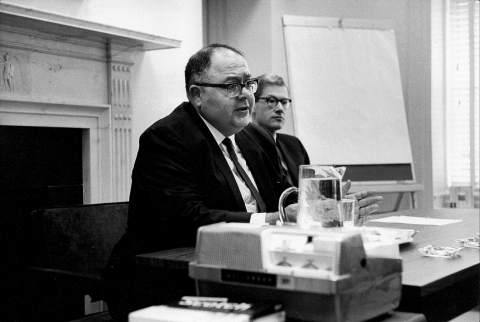It's hard to think of a more irresistible morsel of dubious conventional wisdom than the claim that, driven by demographic change, the presidential electoral map now greatly favors the Democrats. The latest propagation of this myth is found in a long piece by National Review Online's chief political correspondent, Tim Alberta ("Does Donald Trump Have a Path to 270?"), from which Mark Levin read aloud at great length during his radio program on Tuesday. Levin, who has yet to say how he'll cast his vote for president, framed Alberta's piece as being authoritative in portraying dire straits for Donald Trump.
Alberta asserts that the Democrats "entered 2016 with a decided advantage" in the race to get to 270 electoral votes and asks whether Trump "has any realistic path to defeating Hillary Clinton." He immediately responds, "The answer, barring unforeseen and politically transcendent developments, is no." As Alberta explains it, this is largely because, even if Trump were to turn in "a series of virtuoso performances" in the upcoming debates—an unrealistically high bar for any candidate—he "would still be hampered by the one thing he cannot change: the Electoral College." In other words, Alberta claims, Trump likely wouldn't be able to scale "the blue wall" that holds Republicans' presidential hopes at bay.
In truth, however, this "blue wall" doesn't exist. The Electoral College does not give a clear advantage to either political party. Democrats have won the electoral vote in four of the past six presidential elections because they have won the popular vote in five of the past six presidential elections. Indeed, one need look back only four Olympiads—to the year of Michael Phelps's first Olympics—to find an example of a Democratic nominee losing the electoral vote despite winning the national popular vote—and by more than half a percentage point. There is no recent example of a Republican nominee suffering the same fate.
Let's look at the four presidential elections in this century. In 2000, George W. Bush won the electoral vote by a tally of 271 to 266 (with one abstention), while losing the popular vote to Al Gore by 0.51 points. If Bush had done 0.51 points better in every state—thereby making the popular vote dead-even—he would have added New Mexico (which he lost by 0.06 points), Wisconsin (lost by 0.22 points), Iowa (lost by 0.32 points), and Oregon (lost by 0.44 points) to his column, thereby giving him 301 electoral votes to Gore's 236.
In 2004, Bush won the electoral vote by a tally of 286 to 251 over John Kerry (with a John Edwards fan in Minnesota casting one electoral vote for the vice-presidential nominee), while winning the popular vote by 2.47 points. If Kerry had done 2.47 points better in every state, thereby tying his opponent in the popular vote, he would have picked up Iowa, New Mexico, and Ohio in the process, giving him 283 electoral votes to Bush's 254 and swinging the election.
In 2008, Barack Obama won the electoral vote by a tally of 365 to 173 over John McCain, while winning the popular vote by 7.26 points. If McCain had done 7.26 point better in every state, he would have claimed North Carolina, Indiana, Florida, Ohio, Virginia, and Nebraska's 2nd congressional district (worth 1 electoral vote), giving him 260 electoral votes to Obama's 278.
And in 2012, Obama won the electoral vote by a tally of 332 to 206 over Mitt Romney, while winning the popular vote by 3.86 points. If Romney had done 3.86 points better in each state, he would have swung Florida and Ohio into his column, giving him 253 electoral votes to Obama's 285.
Therefore, if the past four presidential elections had been dead-even in the popular vote (with equal movement in all states to get to that result), Republican nominees' average tally would have been 267 electoral votes to Democratic nominees' 271. That's an awfully small wall.
Alberta emphasizes that there are 18 states, plus the District of Columbia, worth a total of 242 electoral votes, that have "voted Democratic in each of the past six presidential elections." First off, it's hardly surprising that with the Democrats having won five of the past six popular votes, a little over a third of the states would have gone with the Democrat all six times. Secondly, there's no guarantee that those 18 states will continue to go the way they've gone. Thirdly, as I wrote this spring, this claim is largely a result of picking a convenient starting date:
"If one includes the past seven elections (four of which have been won by Democrats), going back to George H. W. Bush's win in an open race in 1988, the tallies change dramatically. Over the past seven elections, there are 8 states (plus D.C.) that the Democratic nominee has won each time: Hawaii, Massachusetts, Minnesota, New York, Oregon, Rhode Island, Washington, and Wisconsin. Those 8 states [plus D.C.] total 90 electoral votes. Meanwhile, there are 13 states that Republicans have won every time: Alabama, Alaska, Idaho, Kansas, Mississippi, Nebraska, North Dakota, Oklahoma, South Carolina, South Dakota, Texas, Utah, and Wyoming. Those 13 states total 102 electoral votes.
"So, based on the way things have played out in each of the past seven elections, Republicans start with a 102-90 electoral-vote advantage."
Like most of those who write about the alleged "blue wall," Alberta heavily emphasizes racial demographics. He writes that Georgia's "newfound battleground status"—a peculiar description to apply to a state that was further to the right of the national average in 2012 than Maine was to the left—is owed to "its rapidly diversifying population." But Georgia has moved further to the right of the country as a whole across the past five elections (from 9.68 points to the right of the nation in 1996 to 11.66 points in 2012), not further to the left. He writes that Arizona "is another state that has long been undergoing a demographic transformation." But it too has moved further to the right of the national average—indeed, Arizona's distance from the national average has more than doubled (from 6.28 points to the right of the nation in 1996 to 12.89 points to the right of the nation in 2012) over the past five elections.
Alberta highlights that "whites are shrinking as a share of the electorate" in Florida, yet the Sunshine State moved slightly further to the right of the nation from 1996 to 2012. He writes that "it's incredibly unlikely that Pennsylvania swings back into the GOP column," yet the Keystone State was just 1.52 points to the left of the nation in 2012, suggesting that Romney likely could have won it had he won by just 2 points nationally. He writes that "Trump's numbers in Michigan are dreadful" and that his winning there would take "a miracle." Yet as of Wednesday evening, Clinton's edge in the Wolverine State, according to the Real Clear Politics average of recent polls, is only 3.6 points bigger than it is nationally (8.2 points to 4.6 points—whereas Romney lost to Obama in Michigan by 5.6 points more than he lost nationally (losing by 9.5 points in the state of his upbringing).
Referring to further "changing demographics" in the states of Virginia, Colorado, New Mexico, and Nevada, Alberta writes that "Marco Rubio or Jeb Bush [are] bilingual conservatives who strike a centrist tone and could put many or all of these 'change states' in play." Perhaps—much like centrist West Virginia Senator Joe Manchin likely could have put a lot of states in play for the Democrats. But a viable presidential candidate must first win the nomination of his or her own party, not just win one out of fifty states, as Rubio and Bush collectively managed to do. Besides, Trump appears to be doing quite well in Nevada (he could well become the first Republican to win there since Bush), and he has just begun to buy ads in Virginia and Colorado, where Clinton's strong poll results to date are aided by her having already been on the air there.
In short, as we approach Labor Day, it is far too early to say, as Alberta does, that "Clinton appears certain to win in November." There are plenty of paths to 270 electoral votes for Trump. They all involve his winning, or coming very close in, the national popular vote. Odds are that the electoral-vote winner will closely track the popular-vote winner. If Clinton ends up losing the popular vote by more than a couple of points, the phantom "blue wall" isn't going to save her.
















